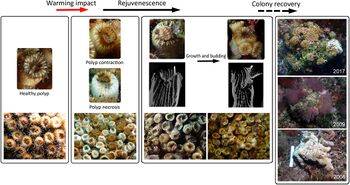Biology:Rejuvenescence
Rejuvenescence is a unique survival strategy observed in certain coral species, which enables them to recover from harmful warming events.[1][2][3] This strategy involves the contraction and subsequent rejuvenation of individual coral polyps within a colony.[1] During warm periods, the polyps shrink inward and abandon their skeletons, only to later regenerate and rebuild their colonies.[1] This mechanism involves a decrease metabolic activity, leading to a significant shrinking of the polyps, their partial retreat from inner skeletal structures, and the formation of a new protective cup, known as a calyx.[3]
Rejuvenescence represents the ability of corals to adapt and persist in the face of environmental stressors, providing hope for their resilience in the context of climate change.[1] This survival mechanism, previously known only in extinct fossil corals, has now been documented in living corals in the Mediterranean Sea, specifically Cladocora caespitosa.[1][2] A study published in 2019 gives insight on the significance of rejuvenescence and its potential implications for the long-term survival of coral reefs.[1][2]
References
- ↑ 1.0 1.1 1.2 1.3 1.4 1.5 Georgiou, Aristos (2019-10-09). "These Coral Have a Unique Survival Strategy to Recover From Deadly Events". https://www.newsweek.com/coral-unique-survival-strategy-deadly-warming-events-1464202.
- ↑ 2.0 2.1 2.2 Kersting, Diego K.; Linares, Cristina (2019-10-04). "Living evidence of a fossil survival strategy raises hope for warming-affected corals". Science Advances (American Association for the Advancement of Science (AAAS)) 5 (10). doi:10.1126/sciadv.aax2950. ISSN 2375-2548.
- ↑ 3.0 3.1 "Some Corals Can “Rise From the Dead” After Lethal Warming Events". 2019-10-09. https://www.aaas.org/news/some-corals-can-rise-dead-after-lethal-warming-events.
 |


